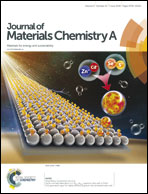Naturally abundant high-performance rechargeable aluminum/iodine batteries based on conversion reaction chemistry†
Abstract
Rechargeable multivalent ion (Al3+, Mg2+ and Zn2+) batteries provide a viable alternative to lithium ion batteries because of the supply risk of lithium resources and safety concern. In this study, rechargeable metal–iodine batteries, particularly aluminum/iodine batteries, were fabricated with novel active carbon cloth/polyvinylpyrrolidone (ACC/PVPI) composite cathodes prepared via a facile solution-adsorption method combined with freeze-drying. The use of active carbon cloth (ACC) endows the composites superior electronic conductivity, and significantly decreases the weight of the electrode due to its function as a current collector. Hydrogen bonding interaction between PVP and iodine in PVPI guarantees the depression of the shuttle effect of polyiodide, thus lengthening the cycle life. The density functional theory (DFT) analysis shows that such shuttle depression occurs due to the hydrogen-bonded iodine species, and the relatively large formation energy hints at higher conversion reaction efficiency of Al ion batteries. These characteristics make the composites an ideal electrode in various metal ion batteries. To be specific, the Al/I2 battery with a distinct working potential window achieves a high capacity of 180.1 mA h g−1 at 0.2C and can remain stable after 500 cycles with a stable capacity of 127 mA h g−1 at 0.6C. Moreover, at higher current density of 1C, the battery delivers a capacity of 102.7 mA h g−1 for up to 1050 cycles. These above-mentioned characteristics of metal–iodine (Li, Mg and Al/I2) batteries, related electrochemical performance measurements and theoretical modeling analysis show that the rechargeable iodine-based batteries provide a promising direction in designing high-performance energy storage/transfer systems.



 Please wait while we load your content...
Please wait while we load your content...